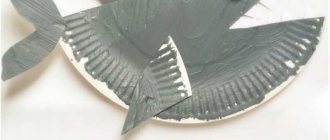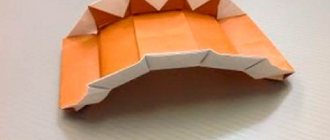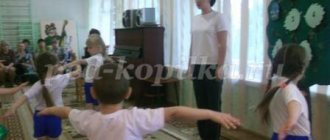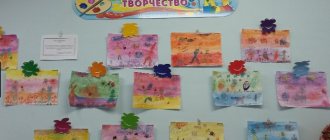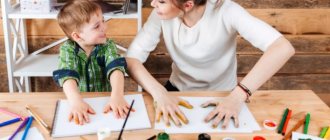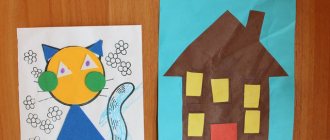Progress of the lesson to study the topic “Utensils”
1. Lesson “Magic bag”
“I have this beautiful bag, and there’s something in it.” Let's see what's inside? Children take turns taking objects out of the bag. Children (3-4 years old) - one object at a time, name it and put it on the table. The older ones try to guess the object by touch, take it out and put it on the table.
2. Conversation
— How can you call all these objects in one word? - Why do we need it? For children (3-4 years old) they name a specific item and ask what we need it for.
3. Lesson “Feed Masha”
— The doll Masha came to visit us. And as is customary, guests must be treated to something. — Let's prepare lunch for our guest. What do we need for this? (Pot, ladle, frying pan) The utensils that we need for cooking are called kitchen utensils. - Let's feed Masha our lunch. What will we take for this? (Deep plate, shallow plate, fork, spoon) The dishes from which we eat are called tableware, and what we use is called cutlery. - Well, after lunch you can give Masha some delicious tea. Take the dishes that we need for this (teapot, saucer, cup, teaspoon). It's called a tea room.
4. Physical school
5. Lesson “What is it stored in?”
Illustrations are posted on the board. Children (5-7 years old) say the answer themselves. An adult helps the younger ones. — Sugar (in a sugar bowl) — Salt — Pepper — Butter — Bread — Sweets — Sauce — Tureen
6. Lesson “What dishes are made of”
An adult places plates (salad bowls) on the table. - How are all these objects similar? (form, purpose) - How are they different? (color, material of manufacture) - Dishes are made from different materials.
Tell me the name of the dishes made from: Glass Wood Porcelain Plastic Metal (Older children name it themselves, younger children with the help of an adult) - If you drop a glass plate, what will happen to it? — If you drop a spoon on the floor, what happens to it?
7. Activity “Collect the fragments”
Children are given pictures of objects cut into several parts. We need to collect pictures. “I wasn’t careful today and broke several objects.” Collect the pictures and find out what was broken.
8. K. Chukovsky “Fedorino’s grief”
- Let’s remember the fairy tale “Fedorino’s grief.” - What happened to Fedora? - Why did the dishes run away from her? — How should you care for plates, forks, and spoons?
9. Summary of the lesson
— Today we talked about dishes, that they are very important and necessary in our lives. We found out that it can be a tea room, a kitchen room, or a dining room. It is made from various materials, so it can be glass, porcelain, wood, or metal. Some materials make it strong, while others make it fragile and can be broken. The dishes must be handled very carefully, washed and put back in their places.
Thematic selection of games and exercises, topic: “Dishes”
Goals:
Expand children's knowledge about dishes and their purposes. Teach children to name an object and possible actions with it. Consolidate knowledge about color, size, quantity. Continue teaching children to count objects; learn to understand the concept of “half”. To develop the ability to distinguish non-speech sounds: hitting plastic, wood, metal, ceramics with a spoon. Replenish children's vocabulary on the topic. Strengthen the skills of gluing, sculpting, and finger painting. Develop memory, attention, fine motor skills, coordination of movements.
Equipment:
“Wonderful bag” with doll utensils: pot, cup, plate, frying pan, spoon, knife, kettle. Wooden, plastic, ceramic, metal plate. Plates in yellow, red, green and blue. Colored silhouette pictures of green cucumbers, red apples, yellow pears, blue plums. Sheets of paper with a drawn table, plate and napkins. Silhouettes of cups and a teapot cut out of colored paper. Yellow plasticine. Poppy. A sheet of paper with a picture of a saucepan (kettle). Finger paint. Cardboard “fork” blanks without teeth, multi-colored clothespins. Handkerchief, napkins, cups. Pictures of “flies” cut out of paper. Sheets of paper with dark silhouettes and similar colored pictures of dishes. Plastic vegetables made of two halves, fastened with Velcro, knives. Pyramid in the form of cups. Silhouettes of frying pans, salt dough, knives, and planks cut out of black cardboard. Toy food set, toy stoves, pots and pans. Building material: cubes and bricks. Little nesting dolls. Small toy dishes. Picture of a cup. Plasticine. Audio recordings “Shoo, fly, fly away”, “We are clinking dishes”, “The bear is clinking with a spoon”.
Game situation “What’s in the bag?”
Guys, today there is something interesting for you in a wonderful bag. Lower the handle and take it out. Pot, kettle, frying pan, plate, spoon, cup, knife. All these items can be called in one word - dishes.
Didactic exercise “What is this?”
This is a saucepan. You can cook soup in it. This is a plate. You can put food in it. This is a spoon. You can use a spoon to scoop up food and put it in your mouth. This is a cup. You can pour tea into it and drink it. This is a knife. They can be used to cut bread. This is a frying pan. You can fry cutlets on it.
Didactic game “Put the food on plates”
Look what products we have: green cucumbers, red apples, yellow pears, blue plums. You need to place these products on plates of the same color.
Applique and modeling “Tea set”
There is a table in front of you (drawing).
Show where the plate, large napkin, and small napkins are on the table. How many large napkins? One large napkin. How many small napkins? Two small napkins. Take the boxes and see what's in them. Teapot and cups.
How many cups? Two cups. How many teapots? One kettle. Place napkins, teapot and cups. There is only one kettle and it is large, so you put it on one large napkin. There are two cups and they are small, so you placed them on two small napkins. Now glue the teapot and cups.
Now it would be nice to make bagels for tea. Take plasticine and roll it out into a thin sausage. Take it by the ends with both hands and wrap it into a ring. Connect the ends. It turned out to be a bagel. Place it on the plate and press down with your palm. Sprinkle poppy seeds on top and press with your finger. Make another bagel in the same way.
Didactic game “What’s missing?”
There are dishes in front of you: a saucepan, a cup, a spoon, a plate. Remember them. Now I will cover the dishes with a handkerchief, and when I open it, something will be missing. What is missing?
Breathing exercise “Shoo, fly, fly away”
A fly flew in and landed on the dishes. - Shoo, fly, fly away! You have no business doing anything on our dishes. Blow on the fly to make it fly away.
(Cut out drawings of flies are distributed to the children. The exercise is repeated several times).
Finger gymnastics “Helper”
Our Antoshka washes the dishes. (Rub your palms apart)
Washes fork, cup, spoon. (Extend your fingers from the fist, starting with the little finger)
I washed the saucer and glass. And he closed the tap tighter. (Imitating hand movement)
Game with clothespins “Fork”
Here is a fork without tines. Make tines on the fork using clothespins.
Didactic game “Setting the table”
In front of you in the picture there are dark spots - shadows. You need to place a suitable shaped dish on top of each shadow: plate, fork, knife, spoon.
Didactic game “Sorting dishes by size”
We washed the dishes clean. We didn’t forget to dry them: Cups and saucers stand in a row And sparkle in the sun.
Make a pyramid of cups. Then stack the cups on top of each other.
Musical and rhythmic exercise “We are clinking dishes”
Children make sounds using various utensils to the song “We Clink the Dishes.”
Finger painting "Pan"
Color the pan: put a fingerprint in the empty circles and paint over the stripes.
Reading the poem "Dishes"
Girl Irinka was putting things in order. Girl Irinka said to the doll: “The napkins should be in the napkin holder. There should be oil in the oil can. There should be some bread in the bread bin. What about salt? Well, of course, in a salt shaker!”
Bas-relief modeling “Decorate the cups”
The cups are new for Mitya. So that he can drink tea, milk and lemonade. We need to decorate the cups.
Pinch off pieces of plasticine and roll into balls. Apply to the cup and press.
Musical and rhythmic exercise “The bear clinks with a spoon”
(Performed to the song of the same name).
Construction “We are waiting for guests”
The nesting dolls are going to come visit us. The nesting dolls are small and it won’t be possible to seat them at our large table, so we need to make small tables and chairs for the nesting dolls. Take a cube, place it in front of you, and place a brick on top of the cube. Like this. The result is a table. Now let's make a chair. Place it near the table, and place a brick behind it. Like this. (Vertical). The result is a chair with a back. And here are the nesting dolls! Have them sit on small chairs. And put the dishes on the table.
Examining plates made from various materials
Here are the plates in front of you. Let's count them. One two three four. How many plates are there in total? Four plates. All plates are different. Here is a ceramic plate that is well known to everyone. Tap it with a spoon and listen to the sound you get. Here is a metal plate. Tap the spoon on it too. Here is a plastic plate. Tap it. But the plate is wooden. Knock on this plate too.
Didactic exercise “Tricky spoon”
We will play with a spoon and name the dishes.
Close your eyes, come on, guess which plate the spoon is knocking on.
Didactic game “Cut into two halves”
Using plastic knives, children “cut” vegetables into halves (secured with Velcro).
How many pieces did you cut your product into? Let's count: one, two. You cut it into two halves.
Modeling salt dough “Pancakes in a frying pan”
Roll out the dough straight into a thick sausage. Cut the sausage into pieces with a knife. Squeeze each piece between your index finger and thumb, place it on the pan and press.
Summary of a lesson on paper design in the middle group. Theme "Dog Kennel"
"Dog Kennel"
Goal: to learn how to make simple paper crafts based on a new design method - folding paper in half.
Tasks:
-learn to analyze paper crafts: identify parts, their spatial arrangement relative to each other, location of parts on a plane;
-learn to fold a sheet of paper in half (lengthwise, crosswise);
- learn to round two corners of a square so that it becomes a semi-oval;
-continue to teach how to work carefully with glue and napkin;
Materials and equipment (for each child): thick sheet of paper 11x22 cm; strip of brown paper 13x4cm; a square sheet of black paper measuring 5x5 cm; PVA glue; scissors; dog figurines; a booth constructed by a teacher from a box.
Progress of the lesson:
A ball game is played “Who lives in which house”. Children stand in a circle facing the teacher. The teacher has a ball in his hands.
Educator: Guys, I will throw the ball and name the animal or bird. And the one who caught the ball names where this animal or bird lives.
Throws the ball: Fox (in a hole), crow (in a nest), squirrel (in a hollow), etc. The game is played several times.
Children sit at tables on which everything necessary for work is prepared.
Educator: Look what I have prepared for you (shows his craft booth). Who lives in the booth? (dog). Yes, the dog Zhuchka lives in the booth with his puppies.
Next, the teacher analyzes the craft: My booth has a roof, it is glued to the wall on top, and a black hole is glued to the wall in the middle.
Educator: Zhuchka’s puppies will soon grow up, and it will be cramped for them all to live together. Let's help the dogs and build booths for them.
The teacher shows and explains the techniques: how to fold a thick sheet of paper crosswise and bend a strip of paper lengthwise; how to round off two corners of a square to make a hole for the dog, how to apply glue to a part, how to use a napkin, check whether it is well smeared. Invites children to examine the prepared parts.
Educator: Before we get to work, let's warm up.
Physical school is being held.
One - rise, stretch, (Stretched.) Two - bend, straighten, (Bent your backs, hands on the belt.) Three - clap your hands, three claps, (Clap your hands.) Three nods with your head. (Move your head.) At four - arms wider, (Arms to the sides.) Five - wave your arms, (Swing your arms.) Six - sit down again. (Sit down.)
Educator: Well done, now let’s get to work.
At the end of the lesson, all works are placed side by side. A large dog runs between them.
Educator: Guys, look how happy Zhuchka is. Apparently she really likes the houses you designed for her puppies. She thanks you. Let's let all the puppies out of the bug box, let them look at their future homes. Dasha, raise the booth, who did you find there? The girl takes out the dogs, the teacher distributes them to the children. Children play with dogs.
List of used literature:
Kutsakova L.V. Construction and artistic work in kindergarten: Program and lesson notes. –M.: Sphere shopping center. 2

